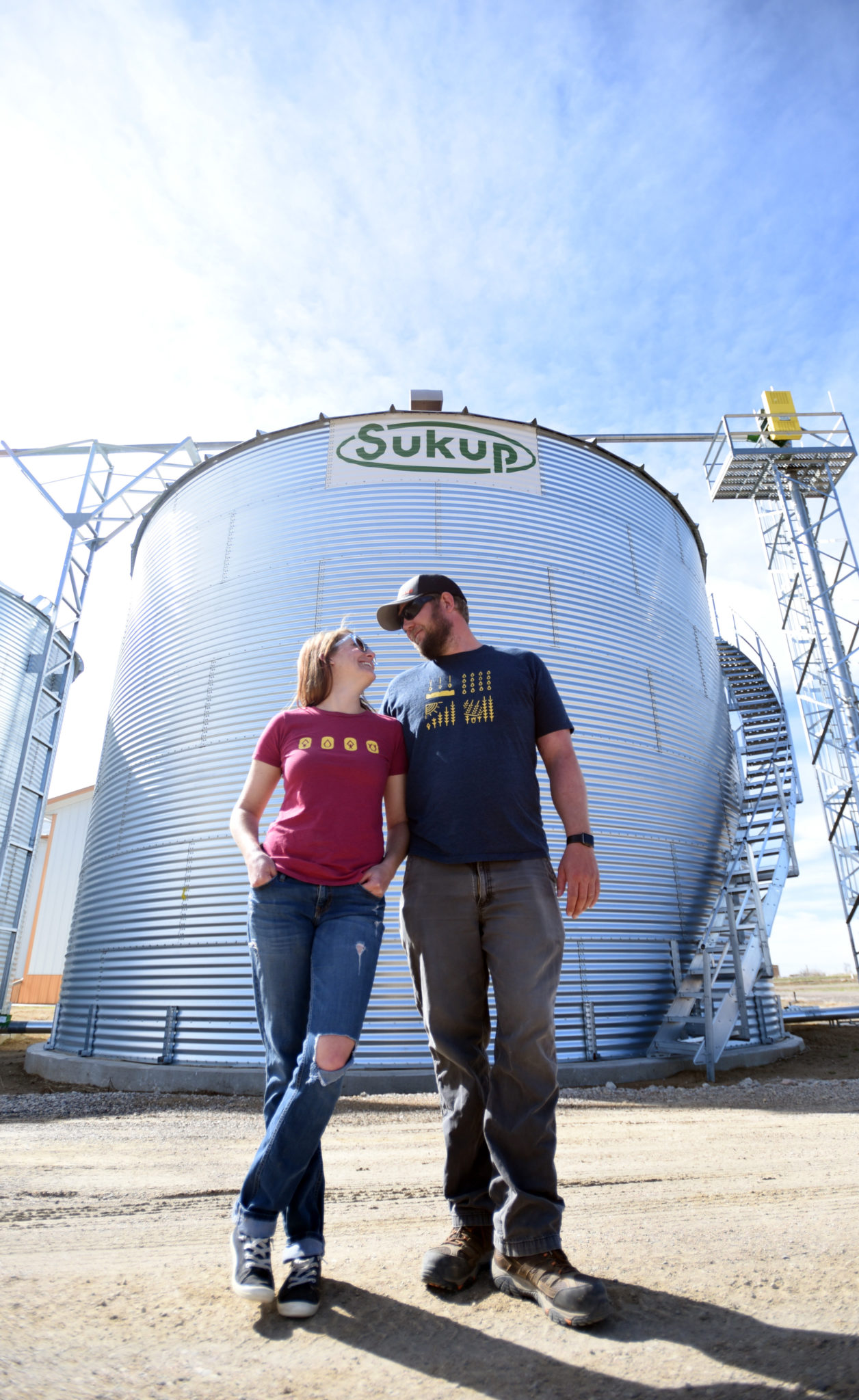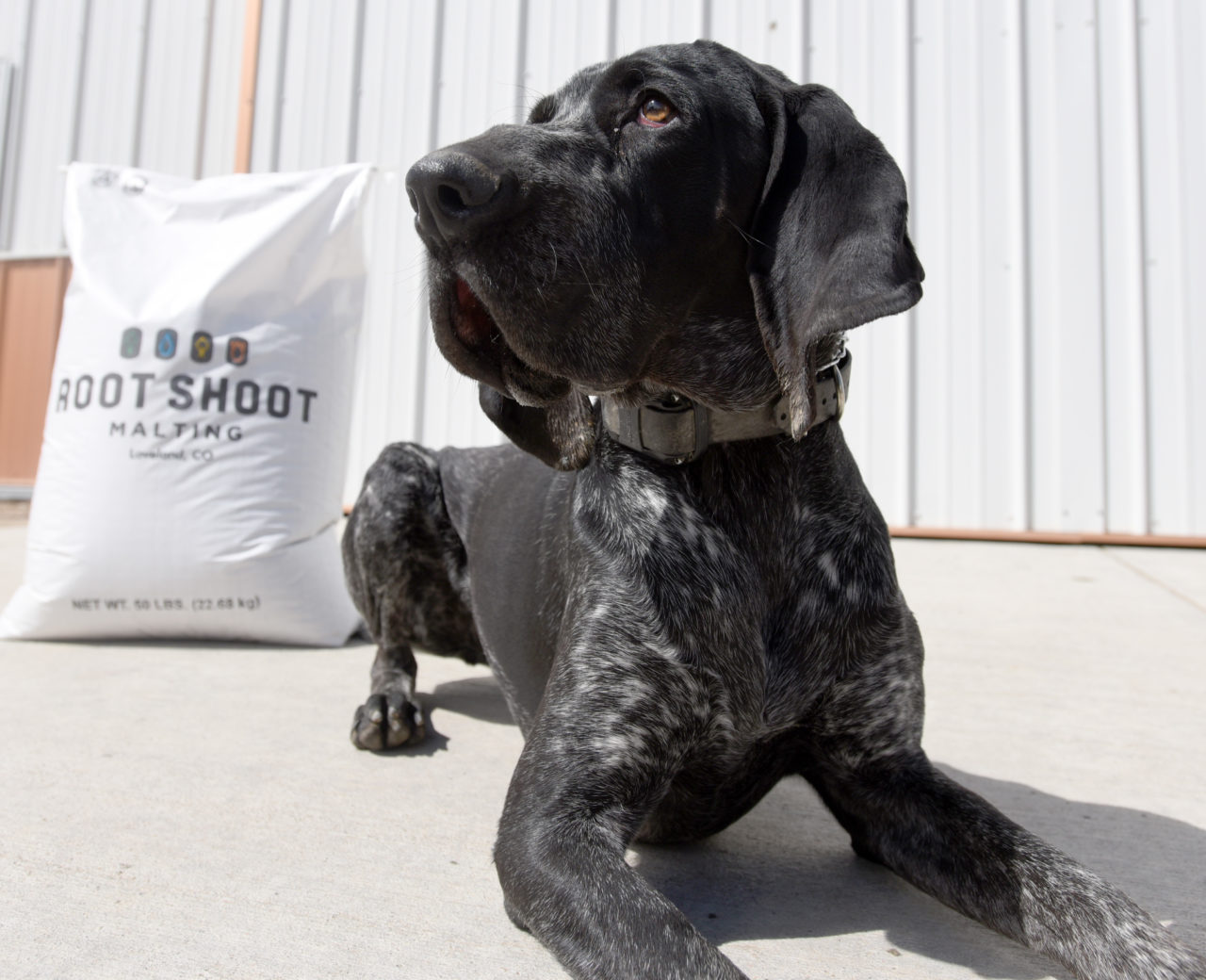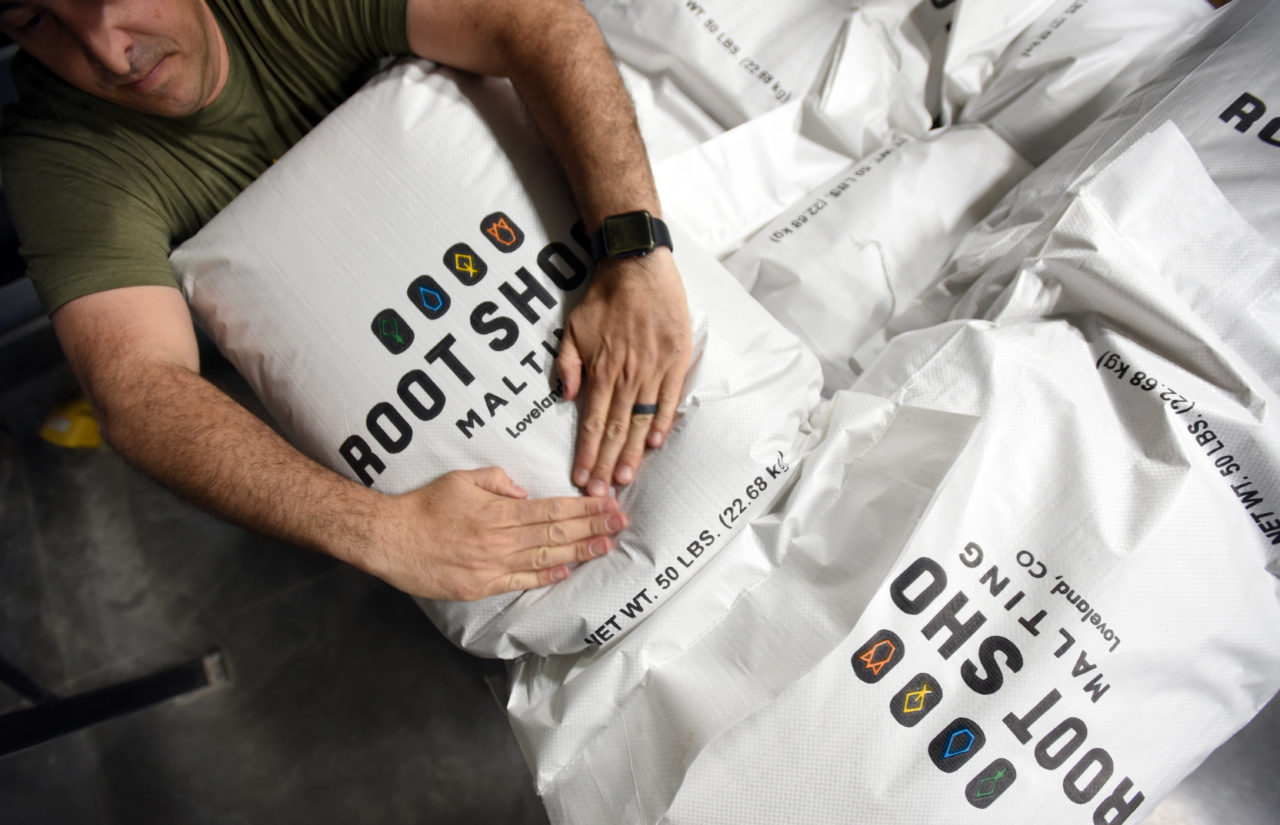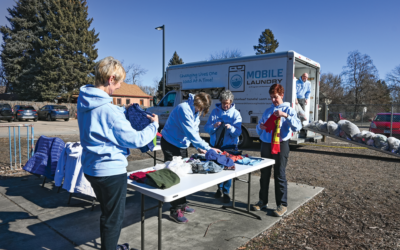By Kristin Owens | Photos by Josh Polson
With their long history and strong ties to the land, the Olander family is all about innovation and preserving local agriculture. With generations of farming under their belt, they’re no strangers to the industry.
The Olanders have long produced corn and alfalfa to supply local dairies, along with a small portion of grain to large breweries. However, in 2015, Emily and Todd Olander reimagined 1,500 acres of Loveland farmland into a unique business. The move took some guts, and an unwavering belief the Colorado community would rally along. They swapped the bulk of their fields from dairy cow silage to production of non-GMO barley, wheat, rye and corn for craft breweries and distillers.
“You can’t learn if you don’t try,” Emily says. Now, barley, wheat and rye make up the bulk of their fields.
Understanding customers could get high-quality grains anywhere in the world, Emily and Todd added another component: a malthouse. And not just any. They doubled down and purchased the first Kaspar Schulz malting system in the United States, an energy-efficient, multi-ton German technological wonder. And since ‘malt is the soul of beer,’ they made sure the excellence of the malting process matched the quality of their grains.
They produced Genie-Pale, a high-dormancy malted barley prized by craft breweries. Big macro breweries typically use Moravian, which has lower protein and moderate enzyme levels that result in higher yield. Think ‘economical.’ And even though the Olanders had contracts with some big-name, well-recognized clients, they decided the macro business relationships felt “too corporate,” says Todd. They organically gravitated to the smaller Colorado craft brewers—the innovators. Logical because, “both brewers and farmers share a passion for their craft,” Emily explains. And it was a perfect match. Root Shoot Malting was off and running.
What’s malting? It’s a required process to make alcohol. Basically, grains like barley are harvested, soaked in water, stored in a cool, aerated place for sprouts to grow, then heat is applied in a kiln to dry and toast the grain. Simply put, malting prepares the grain so sugars can be extracted. Malts are also the source of flavor, aroma and color for beer and spirits. Otherwise, no Hefeweizens. No Stouts. No Pilsners. No whiskey. No vodka. No gin. No bourbon. You get the point.
 Always about the land
Always about the land
Despite their progressive thinking, the Olanders love and respect the history of their land. And with ownership comes responsibility for future generations. So, if you ask them what their biggest change was, it would be about transition to regenerative practices, like composting and using green manures to build up their soils.
Instead of heavy tilling, crops are consciously and methodically rotated, focusing on soil health. Their farming processes limit inputs to counteract greenhouse gases and add more carbon back into the soil.
Were they anxious? “Yes! It’s unknown territory for us. Other farmers practicing these methods are in completely different climate/ecosystems, so it’s difficult to relate,” Emily says. But these measures resulted in a product that buyers will pay a premium for: ethically grown, superb grains. And subsequently, award-winning malt.
Work, work, work
Their business sky-rocketed. In 2016, they utilized one drum and produced 10 tons of malted grain a week. In 2018, it grew to two drums and 20 tons of malt a week. A third drum is scheduled for installation in 2022.
Root Shoot Malting was one of the first 15 malthouses in the United States, and being on the cusp of a thriving niche-business takes some luck, and more importantly, skill and attention to detail in order to stay ahead
.Yet, they’re a small business with only four full-time and four part-time employees. And they consider themselves a small farm. Everyone on the team works hard: planting in late February and harvesting in July to store up to two years supply of barley, an insurance against a bad harvest. In addition to the planting and harvesting, malting is a week-long, on-going process. When one batch is done, another goes into a drum. It is a continual production cycle, and they recently celebrated their 300th batch.
Over time, they’ve settled on 14 varieties of craft malt. The most popular, a pilsner/pale, is a lightly-kilned base malt which totals 80 percent of production. Their specialty malts comprise the remaining 20 percent. They hand-package and self-distribute to customers several times a week. The work never stops.
The business grows as their customers do—again, an organic relationship. When the COVID pandemic hit last year, it was a rough two months as taphouses tried to pivot and work with limited hours, seating and traffic. But, in hindsight it worked out. “Instead of customers buying a beer or two, they picked up growlers and six packs to take home,” recalls Emily. More sales. More beer. More orders. Coloradans rallied and, luckily, businesses saw an uptick. It turns out, there’s always a demand for quality beer.

Look locally
‘Shop local’ and ‘Colorado-grown’ aren’t just fancy marketing tools. They’re also philosophies which ground not only the Olander’s business plan, but other local entrepreneurs as well. For craft brewers, like new Stodgy Brewing Company in Fort Collins, they rely on top grain and malt production.
Ingredients, “shouldn’t be about marketing or green-washing,” says Natalie Yoder, co-owner of Stodgy. It’s really about quality products sourced locally. With her agriculture background, Yoder is well-versed in the arena. “You always want the best product. And the commodities are right here…why not use them?”
Local food chains are important to support the agriculture systems already in place. People should buy craft beer, “because it’s GOOD. Not just because the ingredients were sourced locally,” Yoder says. And lots of other craft brewers agree. Root Shoot supplies Avery, City Star, Gilded Goat, Oskar Blues, Odell’s, Grimm Brothers and Verboten, all distinguished breweries throughout the state, with their craft malts.
More partners, more products
It’s not just about beer, either. Rob Masters, head distiller for The Family Jones in Loveland, uses Root Shoot for his award-winning spirits, a no-brainer since Rob drives by the Olander’s fields every day. And buying locally also cuts down on shipping carbon footprints, especially if ingredients are just down the road.
But it’s not just out of convenience; the Olanders collaborate with him on new products. They grow Oland wheat, an heirloom grain from Scandinavia, to produce his Scandinavian-style vodka, Annika Jones, a single-estate spirit.
And that’s the beauty of working with Colorado farmers, because “I get to shake their hand,” Masters says. They’ve not only developed a partnership, but a relationship of trust. If Masters needs three acres of Oland wheat next year, it’s a simple phone call to Todd to discuss.
Even though growing and distilling better-quality grains may result in lower yields, Masters says, “Flavor is always more important to business.” Whether distilling award-wining spirits or producing craft beer, quality wins over quantity every time.
The future?
Emily and Todd are now Colorado maltster mavericks with over 200 clients, or as they say, “partners.” Their craft malt is in high demand all over Colorado. But with farming, there are always challenges. Their biggest one? Land.
Todd says he’d love to see “opportunities for longer land leases to help farmers plan ahead and feel more stable with their businesses.” Imagine not knowing if your prime resource, your land, will still be available in five years? It’s hard to plan long-term strategies, and businesses need that capability or may fail to see turns in the road ahead. The Olanders are working with Colorado Open Lands to pursue a conservation easement that will protect their land from future development.
There’s also limited water. Normally the local rivers give plenty of water, but the more housing developments built, the fewer water sources available for farms. It’s a shrinking resource.
New residential communities and fracking operations are forcing family farms to consider dollars over agriculture. It’s easier to relinquish precious acres when a lot of cash is waved around to incentivize a sale.
So, what does Colorado’s farming future hold? The next time you sip that libation of choice, it’s something to consider. As Root Shoot’s customers (oops, partners) support local ingredients and continue to buy, malting is here to stay. Which means barley gets planted. And the farmlands remain. And we drink delicious beverages.
But in the end, “The educational component is always key; the community needs to be made more aware,” Todd says, of the plight farmers are facing.
And the Olanders are pushing the message. It’s a success that is reciprocal because everyone wins economically: Existing industries expand, new businesses begin, more jobs are created, tax revenue increases, more sales are generated, the list goes on. Good home-grown products can be evolutionary. And it when it comes to entrepreneurship, Emily reminds us, “Learn to expect the unexpected, be resilient and don’t underestimate yourself!” Because as long as our Colorado farmland exists, there’s innovation to be had. And thanks to the Olanders, that’s progress.

By the Numbers
- 5 generations of Olander Farming
- 1,500 acres
- 2,000-pound super sacks
- 20 tons of malt a week
- 185 degrees Fahrenheit to roast
- 3 national awards
- 1.5 million pounds of malt
- 5 years in business
Learn More
View the documentary short film 100 Year Lease, produced by Root Shoot Malting and Traverse Image, to educate the public on the significance of family farms and the preservation of Colorado agriculture. View the documentary at rootshootmalting.com/100yearlease.
New words to impress your friends with
- Diastase – group of enzymes which convert starch to sugar
- Green Malt – wet malt before drying
- Kilning – indirect heat used to dry and toast grain
- Lovibond – scale with toasted grain color degrees
- Maltster – someone who malts barley or other grains
- Modification – when shoots grow to the length of the kernel
- Viability – ability to germinate
Try these local libations using Root Shoot malts:
- Stodgy’s Hazy IPA – a piney, grape-fruity, citrusy explosion of a beer
- The Family Jones’ Atticus Jones rye whiskey – warm on the palate with a spicy finish
Kristin Owens is a Fort Collins-based writer. You can find her published works at kristin-owens.com. To comment on this article,emailletters@nocostyle.com.

![Growing-the-Family-Farm[1]](https://nocostyle.com/wp-content/uploads/sites/31/2018/01/Growing-the-Family-Farm1.jpg)




